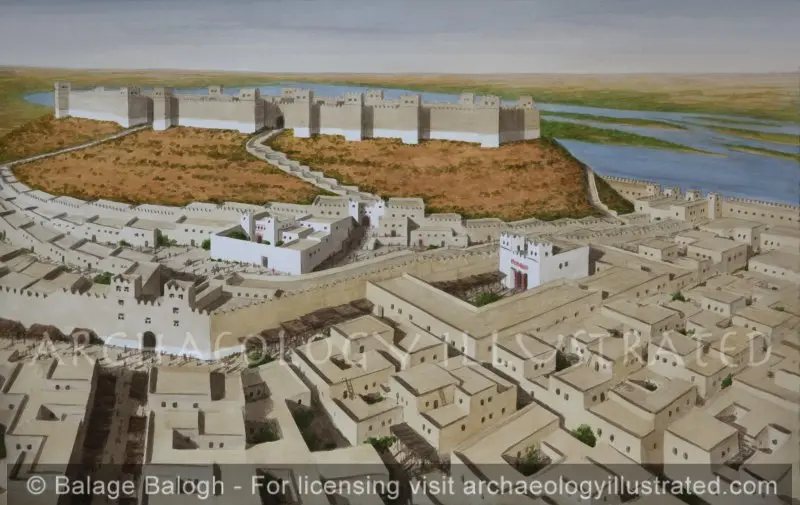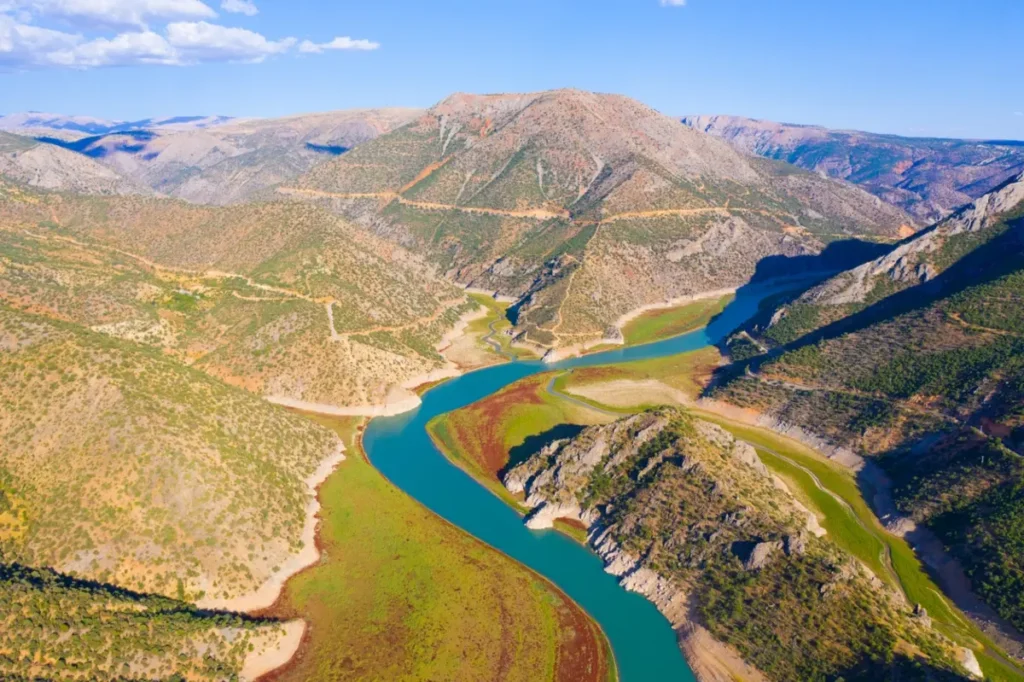
Geographic Location and Origin of Name
Nestled on the banks of the Euphrates River at the Turkey-Syria border, Carchemish is famous for its rich antiquity. Its name, derived from ‘Karkamis’, means ‘Quay of Kamis’, signifying its significant role in ancient maritime activities. Acclaimed for its strategic location, it connected the eastern and western worlds during ancient times.
Archaeological Significance
Spanning multiple eras, Carchemish has been notably significant in the field of archaeology, offering in-depth insights into ancient civilizations. Uncovered relics, structures, and inscriptions unearthed from this region represent the rich cultural heritage and historical timeline, dating back to the late Neolithic period. The city, once a strategic hub along the important Euphrates trade route, witnessed the rise and fall of numerous empires. Excavations have revealed the influence of Hittite, Assyrian, and Roman civilizations in its architectural designs and societal structure. Hence, Carchemish serves as a valuable archaeological site, epitomizing ancient human culture, economy, religion, and politics.
The Early Age Period
The Chalcolithic Period
During the Chalcolithic Period, or Copper Age, Carchemish underwent profound changes. This era, ranging roughly from 4500 to 3000 BC, witnessed advancements in tool-making with the discovery and exploitation of copper, paving the way for more intricate craftwork and trade. The society transformed from primarily farming-based to a complex civilization, experiencing a surge in population and architectural developments. The introduction of pottery, ornamental artifacts, and rudimentary metallurgical techniques marked innovative growth. Intriguingly, archaeological excavations have unearthed significant evidence of ritualistic practices hinting towards organized religion, further underlining the culture’s evolution. This era laid a robust foundation for the advanced Bronze Age that followed.
The Early Bronze Age
During the Early Bronze Age, Carchemish evolved into an influential city-state, shedding light on the importance of this era. Excavations reveal the growth and development of the city during this period, with an advanced fortification system and monumental structures. The artifacts found, including pottery and metalwork, suggest extensive trading connections with neighboring regions. Hieroglyphs from this era are vital to understanding societal norms, religious practices, and political dynamics. These findings collectively depict a thriving community with strong martial prowess and economic stability, making Carchemish a frontrunner in the cultural and political landscape during the Early Bronze Age.
The Middle Bronze Age
In the Middle Bronze Age, Carchemish emerged as a significant city-state. This period, beginning around 2000 BCE and lasting until 1550 BCE, saw the city flourish as an influential Hittite hub, establishing vital trade links and exerting substantial political clout. Remarkably preserved relics from this period include pottery, statues, and cuneiform inscriptions, which offer valuable insights into the socioeconomic structures and religious practices of the city’s inhabitants. Archaeological discoveries also demonstrate a high degree of craftsmanship and a refined aesthetic sensibility indicative of Carchemish’s cultural sophistication during the Middle Bronze Age.
The Late Bronze Age
Rise of the Hittite Empire
During the Late Bronze Age, the previously modest city of Carchemish gained prominence as a significant hub within the Hittite Empire. This escalation was largely due to two interconnected factors: its strategic location on the Euphrates River, and the ascension of the Hittites in geopolitical affairs. The settlement, ideally placed for trade and military expeditions, attracted the attention of these industrious rulers, who then transformed it into a grand city and regional power center. As the Hittite Empire expanded, Carchemish played a pivotal role due to its proximity to regions rich in resources and trade networks. Notably, around 1340 BC, it became a ‘viceroyalty’ of the Hittite king, highlighting its importance in the Empire. The influence of Hittite architecture, language, and customs during this period greatly shaped the evolution of Carchemish’s culture and societal norms. This era of the Hittite ascendancy marked the city’s golden age, leaving an indelible mark on its history.
End of the Hittite Empire and Carchemish autonomy
As the Bronze Age neared its conclusion, significant changes occurred that drastically altered Carchemish’s political standing. The decline and collapse of the Hittite Empire in the 12th century BC was prompted by invasions by the ‘Sea Peoples’ and internal instability. This cataclysmic event led to the end of Hittite sovereignty over Carchemish, fundamentally changing the city’s future. Following the fall of the Hittites, Carchemish was endowed with a new autonomous status that saw it rise as a small Neo-Hittite kingdom, retaining its cultural roots while charting its own independent course. The city’s newfound freedom allowed it to thrive, becoming a significant regional power in Northern Syria. As an autonomous entity, its influence extended over the surrounding areas during the Iron Age until its inevitable decline under Neo-Assyrian domination, marking the ebb of its golden age.
The Neo-Assyrian Period
Fall under Assyrian Rule
During the Neo-Assyrian period, Carchemish was an influential city that eventually fell victim to Assyrian domination. This groundbreaking change came in the late 8th century BCE, when Tiglath-Pileser III, the then Assyrian king, annexed the prosperous city as part of his extensive empire. The city survived as a semi-independent entity, albeit under Assyrian leadership, benefiting from its strategic location on trade routes. It flourished as a cultural hub, merging Assyrian influences with those of the indigenous Hittite and Luwian cultures. Despite these advantages, the Assyrian hegemony was oppressive, eventually leading to rebellion and the city’s further decline.
Rebellion and Revival Efforts
During the Neo-Assyrian period, Carchemish experienced significant unrest and upheaval. Struggling beneath the weight of Assyrian rule, the city-state broke out in open rebellion, seeking to reclaim its autonomy and power. Revitalization efforts included fortifying the city’s defenses and revitalizing economic trade. The rulers attempted to establish connections with powerful allies and maintained diplomatic relations, fostering an atmosphere of cultural and intellectual growth. Despite the severe obstacles, Carchemish’s tenacious spirit led to its re-emergence as a vibrant and dynamic geopolitical force. This period showcases the resilience and adaptability which characterized the remarkable city-state throughout its memorable history.
The Neo-Babylonian and Persian Periods
The Fall of the Assyrians and Rise of Neo-Babylonians
As Assyrian control waned, new forces ascended their place in the Near East, marking a crucial shift in the control of Carchemish. The Neo-Babylonians, under King Nebuchadnezzar II, seized the opportunity and prevailed over the last remnants of the Assyrian empire around 605 BCE. Such change of baton unleashed a new era, infusing Babylonian influences in Carchemish’s culture, architecture, and politics. The city thrived, enjoying prosperity and relative peace under Babylonian rule, until the Persians, under Cyrus the Great, further claimed the region by 539 BCE, inflicting another significant transformation in the city’s history.
The Persian Conquest
During the late 6th century BC, the city underwent another significant transformation upon falling under Persian rule. King Cyrus the Great, renowned for his conquests, added Carchemish to his burgeoning Achaemenid Empire. The city became one of the administrative hubs in the empire’s vast network, functioning as a provincial capital or satrapy. Persian influence notably touched on various aspects of the city’s life, fostering a synthesis of cultural aspects distinct to the period. This epoch also saw infrastructural improvements and economic progression, with the administrative shift promoting stability and growth during the city’s incorporation into the Achaemenid Empire.
The Hellenistic, Roman, and Byzantine Periods
Hellenistic influences in Carchemish
The landscape of Carchemish underwent significant transformations during the Hellenistic period, displaying an influential infusion of Greek culture and thought. Following Alexander the Great’s conquest, Greek architecture, language, and arts began to permeate the city, leaving a lasting legacy. There was a proliferation of Greek theatres and temples in the city as well as the widespread use of the Greek language. The distinctive Hellenistic style is visible in the remnants of the pottery and sculptures found, indicating the blend of native traditions with Greek elements. Despite political instability, this era left an indelible imprint on Carchemish’s historical and cultural identity.
Roman Takeover and Influence
Post the Hellenistic reign, Carchemish came under Roman rule around 64 BC, forming a significant part of the Roman Province of Syria. The indelible imprint of Roman culture can be seen in the city’s infrastructure, particularly in its architectural styles that borrowed heavily from Roman design principles. The grandeur of Roman structures such as amphitheaters, baths and roads became an intrinsic part of the cityscape. Their laws also transformed the societal structure, providing a more organised governance system. The transition to Roman rule marked a profound shift in Carchemish’s trajectory towards becoming a more cosmopolitan and influential center.
Byzantine Era and Christian Influence
During the Byzantine Era, Carchemish’s cultural and religious landscape underwent a transformation. This period, starting from the 4th century AD, saw the city adapting to Christian influences. Numerous Byzantine structures, particularly churches, testify to this shift. This era was a testament to the versatility and adaptability of Carchemish throughout history.
Excavations and Discoveries
Early Excavations
The initial excavation works in Carchemish started in the late 19th century under the British Museum’s direction. Most notably, T.E. Lawrence, popularly known as Lawrence of Arabia, was part of the expedition between 1912 and 1914. Archaeologists unearthed invaluable artifacts, revealing insights into ancient Hittite culture.
Recent Archaeological Work and Findings
In recent years, excavations have unveiled critical details about Carchemish’s past. Archaeologists found artefacts like inscriptions and sculptures that indicated the influence of Hittite and Assyrian cultures. Remnants of fortified walls and structures hinted at the city’s strategic prominence. These findings foster a deeper understanding of its historical relevance.



